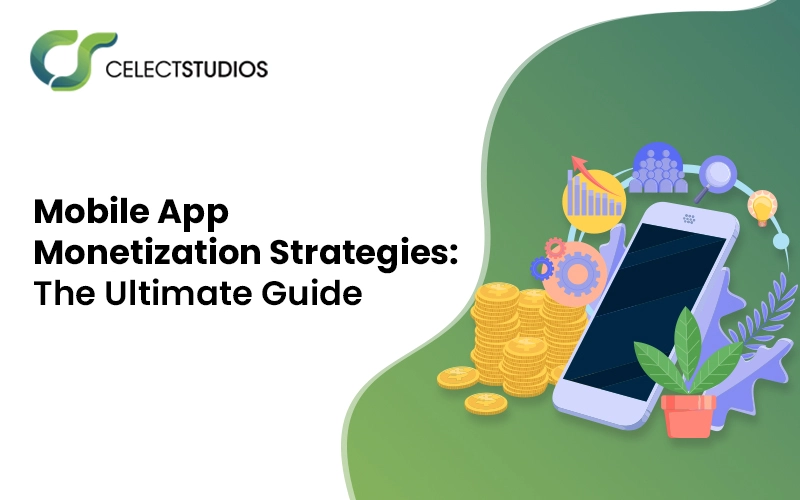After the pandemic, the mobile application industry is on the rise, and its demand is increasing daily. We rely on mobile applications for our daily tasks: planning our day, scheduling our work meetings, editing our content, and playing games or for entertainment purposes. The e-commerce giants like Amazon, Flipkart, Alibaba, etc. are using in-app models. Companies that are investing in the making of mobile applications are expecting to make it a monetization channel. In this blog, we will learn about mobile application monetization strategies.
In 2008, when Google launched its Google Play Store, only some apps were available. Anyhow, with time, countless apps will be present on the Play Store for their users. Now, mobile application companies want to leverage the applications through monetization; with the advancements and introduction of new gadgets like tablets, smartphones, smartwatches, etc., the mobile application industry is on the rise. The money-making possibilities are endless. You can introduce monthly subscription models, put ads in your apps, and sell products.
This blog will teach you all the strategies; you can monetize your application using them. If you are a mobile app development company or any other developer, this article will help you in many ways.
Introduction:
Monetization of mobile applications is not a common method to make money as of now. The increasing demand for a mobile app development company gives it an edge to utilize it as a money-making system, just like a website generates revenue for entrepreneurs.
What is app monetization?
It’s a method to leverage the app’s user base to generate money. It is based on the traditional way of going to a store and giving the customers what they want and getting money; in the same manner, the app leverages visitors into a cash-making system. App monetization works in many ways. The following explanation will give you more clarity on the topic.
Why is it in the spotlight?
The mobile application has made content consumption easier, so there is an increase in demand. Mobile applications are serving every industry we could think of and are becoming a crucial part of every department in any industry. Businesses prefer to sell their products through their personalized mobile applications instead of on e-commerce websites.
Apart from e-commerce, gaming apps are also getting their due recognition, and this industry will reach 2.4 billion dollars in 2020. Apps and smartphones are the digital industry’s future, and any businesses that want to survive and make money should start thinking about leveraging the mobile application industry.
How to make money with mobile application monetization:
There are many methods that businesses can explore to make money through their mobile applications, but all the strategies come with their own set of advantages and disadvantages. We will discuss all the mobile application monetization strategies, and you can choose whichever suits your needs best.
Paid Apps:
We usually go to the Play Store, find the app we want, and download it because mainstream apps are free. However, there is also a market for paid apps, and their demand is growing. Companies have introduced the idea of paid apps to their customers, but the actual thing is how to make app visitors pay for the particular app. This debate is for Android users because iOS customers are willing to pay for exclusive apps. If you developed an app for the Google Play Store for Android users, you should think of other ways to leverage your mobile application’s monetization.
If you still want to use this method, the mobile app developers must create an exceptional application that users will be willing to pay for. This is a real challenge when users must pay for the app they use on a trial basis. Once you overcome the challenge of making a paid app, the next step is to market it to the right audience, which will be willing to avail themselves of that particular application. You have to assume your app is a product that you are going to put on an e-commerce store to get customers for it. You have to find the right marketing channels where your target audience resides to promote your app.
This is the most hassle-free method for revenue generation, but for this, your customer service should be exceptional. This practice will help your customers trust you, actively contributing to monetization.
In-app Purchases:
Amazon, AliExpress, Ali Baba, Flipkart, and other e-commerce applications offer in-app purchases. Mobile game applications also provide in-app purchases for monetization. This is the most common method to make money through mobile applications and is more reliable than other methods. In-app purchases have changed the feeling of satisfaction after buying things using apps, and the typical sense after the purchase has made a shift. In-app purchases build trust amongst their customers; they know the worth of the product they are paying for and know that in case of any problem or damage, their customer service will cater to their needs.
This monetization needs much effort from both the marketing and development ends. The marketing team will have to develop exceptional sales funnels to drive in-app purchases, while developers must make the buying and checkout processes smoother and easier.
In-app mobile ads:
With all the other monetization models coming through, the traditional method of using ads to generate revenue is still popular. There are many apps that utilize the in-app mobile ad method for monetization. Placing ads is the easiest method, and apps have many networks to make this work monetarily. The ads can be of anything, for example, mobile game ads, learning ads, shopping ads, etc. Google AdSense is a common choice for Android users, but other channels are also available.
Let’s discuss the payment methods if you choose in-app ads.
- Effective cost per mile: eCMP is the most common monetization model. In this method, apps get paid by the ad publishers per thousand impressions of their ads. This has nothing to do with the user.
- Cost per click (CPC): As the name indicates, apps get paid a specific amount when users click the ads. This is the most common method to leverage in-app ad monetization strategies.
- Cost per Action (CPA): In this model, the app will get a specific amount of money when a user clicks on the ad and performs a certain action. This method is not so reliable for monetization because it heavily depends on the action performed by the user.
Mobile application development companies must choose the right channel to monetize their applications.
Subscription-Based Model:
As the name indicates, apps will offer subscription programs to their users. This model is time-consuming to attract the right users, but it is highly profitable in the long run. If you opt for the in-app ad model, you’ll be able to squeeze out the money from users only once, but if you offer a subscription, you’ll get a specific amount every month.
Spotify and Netflix are the premium examples of this monetization model. If the app gives its users quality content, they will likely withdraw their subscription. Other than this, hosting websites like Hostinger, Bluehost, Go daddy, and Wix also use subscription-based models to generate revenue.
Banking and Transactional Apps:
We are living in the 21st century, and it’s a digital age. Everybody now owns a bank account, and every bank has its own banking app. Whenever we make a transaction, banks deduct their transaction fee. Bitcoin is among them. This type of monetization is still relatively new. Cash is disappearing with the introduction of credit and debit cards. Developers must work hard to create transactional apps and digital wallets that stand out.
Affiliate Apps:
Everybody is familiar with affiliate marketing by now; this is a method to make money by recommending external products to your audience. Influencers and bloggers earn their living by promoting the brand’s products on their platforms. Similarly, you can sign up for a third-party affiliate app and sell your products and services in that app. Affiliate marketing is subtle and does not come with the hassle of quality control and damage. You can incorporate your affiliate links into other monetization strategies. Based on the niche of your mobile application, you can sign up for the affiliate program for the products and services of your choice.
Best Practices for App Monetization:
Creating apps for monetization is the first step, and the next step is to optimize earnings. Every model of monetization strategy and whichever platform you choose for marketing have their benefits and drawbacks. Let’s discuss some of the best practices for app monetization:
- Don’t rely on one monetization strategy. Always opt for two or three methods side by side. Doing this can reduce your risk if one way does not work.
- If you want to make continuous revenue, you need to optimize your user retention rate. Smooth user experience, easy navigation, user engagement, and app performance contribute to the user retention rate.
- You need to do your marketing beyond the downloads of your mobile application. Your marketing team can generate revenue if they focus on monetization.
Conclusion:
In this blog, you learned about the monetization strategy of mobile applications. You can leverage any system we have discussed according to your mobile application’s requirements. If you want to help create your mobile application and marketing services, you can ping Celect Studios.



